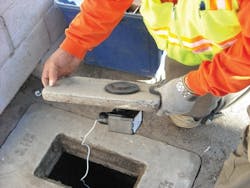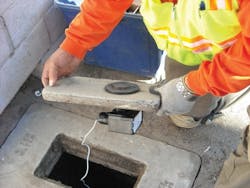By Ali Giti
The City of Gastonia, NC, with 70,000 residents, is located 20 miles west of Charlotte in the state’s southern Piedmont region. Its 25.2-mgd water treatment facility was constructed in 1922 near what is now the center of the city. The facility uses a traditional disinfection / coagulation / flocculation / sedimentation / filtration process to treat surface water drawn from Mountain Island Lake. The man-made lake is fed by the Catawba River and is the primary source of drinking water for residents of Gaston County.
With gaseous chlorine as the primary disinfection method at the water treatment facility, the city was required to develop an evacuation plan in the event of a large scale gas leak under its USEPA risk management plan. However, in the 1990s a three-story courthouse, a prison and a social services building were built near the plant. In fact, the prison and courthouse were positioned adjacent to the chlorine storage building. The evacuation plan that once affected hundreds of residents now affected thousands – including inmates. As a result, the city knew it was time to either move the plant or change disinfection methods.
Alternative Disinfection
Even before the construction of the courthouse, prison and social services building, the city’s public works and utilities department had considered a switch to an alternative means of disinfection. When the 9/11 terrorist attacks took place in 2001, awareness of the potential hazard of transportation and storage of high-pressure chlorine cylinders increased, and the city redoubled its efforts to secure funding for the disinfection switch over. With funding finally assured in 2007, the city began investigating two alternatives: bulk sodium hypochlorite and on-site sodium hypochlorite generation.
“Under the direction of our design engineer, CDM (Charlotte), we performed a fairly sophisticated analysis using different price points for the cost of bulk sodium hypochlorite,” said Edward Cross, division manager, water supply and treatment for the city of Gastonia. “At the time of the analysis, the cost of bulk was relatively low – but now costs have risen again. The operational considerations were significant, too. With on-site generation, a shipment of salt would be delivered every six weeks, affording uninterrupted service in between. However, with bulk, shipments would be received every few days. The frequency of shipments would have required a lot of extra labor to coordinate and physically handle the incoming material.”
An additional benefit of on-site generation over the use of bulk sodium hypochlorite is that, because the unit produces sodium hypochlorite on demand, the technology alleviates the problem of chlorate by-product generation that typically results from the storage of bulk material.
After analyzing the two disinfection methods, Laurin Kennedy, PE, CDM’s principal design engineer on the project, recommended the selection of the ClorTec® on-site sodium hypochlorite generating system from Severn Trent Services. Two 750-lb generating units were installed in January 2010, along with four 12,500-gallon storage tanks. The equipment was provided by Premier Water in Charlotte, with technical information and support offered through the company’s sales representative, Max Foster.
On-Site Generation
The use of on-site sodium hypochlorite generation offers several advantages. The disinfectant is produced and stored in liquid form. Therefore, there is no danger of leaks from gas cylinders. It is also not necessary for facilities using on-site sodium hypochlorite generating systems to develop and maintain a risk management plan. HAZMAT training is not required for handling the disinfectant; nor is there any need for the use of self-contained breathing apparatuses. In addition, on-site systems do not suppress finished water pH to the extent that gaseous chlorine disinfection does. Therefore, the amount of pH adjustment chemical (i.e., lime or caustic) necessary before distribution of finished water is reduced.
The on-site generation process is simple, as three common consumables are used in sodium hypochlorite generation: salt, water and electricity. The system operates by feeding softened water into a brine dissolver. The salt dissolves to form a brine solution, which is further diluted to the desired salt solution and then passed through electrolytic cells. The cells apply a low-voltage DC current to the brine to produce the sodium hypochlorite. The solution is then stored in two of the 12,500-gallon storage tanks. When it reaches the low-level set point, the system automatically restarts to replenish its supply. The 0.8 percent sodium hypochlorite solution is non-hazardous; the only by-product is hydrogen gas, which can be safely vented to the atmosphere.
“From the beginning, safety was the driving force behind eliminating the use of gaseous chlorine at our facility” said Cross. “But the switch provided us with cost savings, too. When we applied for deregistration from our risk management plan and no longer had to perform HAZMAT training, we realized how significant the savings were. We haven’t completed a full cost analysis yet, but we are certain the ClorTec system is providing long-term savings. We have also been impressed with the intuitiveness of the system’s software package. When there is an operational issue, the system tells you what’s wrong, and our staff has been able to handle every maintenance issue.
“In addition to meeting our safety requirements and saving money, the on-site generation system has provided one final benefit: It has operated exactly as we expected. When you make significant capital equipment purchases, you don’t like surprises.”
About the Author: Ali Giti is the director of North American sales for Severn Trent Services’ Water Purification group. In this position, Giti is responsible for the continued development of municipal sales channels, partners and processes for the United States and Canada.
SEVERN TREBT SERVICES® is an exhibitor at the ACE® ‘11 event and can be found at Booth No. 1436
Circle No. 396 on Reader Service Card
More WaterWorld Current Issue Articles
More WaterWorld Archives Issue Articles




